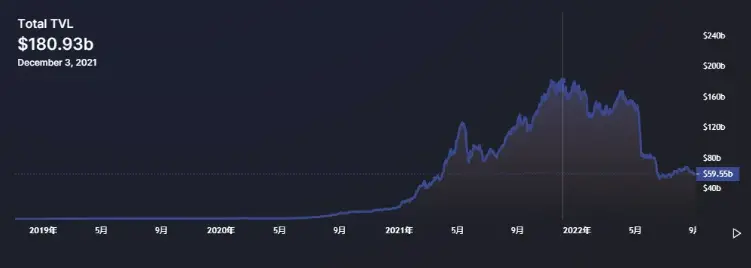Is DeFi dead? Will the DeFi Summer from the last bull market appear again? Where are the opportunities in DeFi?
Since its inception, DeFi (Decentralized Finance) has gone through a complete cycle from obscurity to a fervent peak, and then to a gradual cooling down. Looking back at the last bull market’s DeFi Summer, star projects like Uniswap, Compound, and Aave drove a sharp increase in TVL (Total Value Locked), growing from less than $1 billion at the beginning of 2020 to a peak level of around $100 billion. The rise of liquidity mining, the maturity of the AMM (Automated Market Maker) model, and the expansion of financial tools such as decentralized lending and derivatives immersed the entire crypto industry in the DeFi craze.
However, after experiencing a market frenzy, DeFi began to encounter bottlenecks. High Gas fees, protocol security issues, the short-term effects of mining incentives, and the complexity of user experience have slowed down DeFi’s growth. With the maturity of Layer 2 technologies, the Ethereum merge, and the emergence of various high-performance features, attempts are being made to push for another innovation in DeFi. 
In the decentralized exchange (DEX) space, representative platforms like Uniswap, SushiSwap, and Pancake have adopted different market mechanisms to address liquidity issues:
-
Uniswap: As the first DEX to adopt the AMM model, Uniswap’s V2 version utilizes the constant product market maker (x*y=k), while V3 further optimizes it by allowing liquidity providers to supply funds within specific price ranges, thus enhancing capital efficiency.
-
SushiSwap: Initially a fork of Uniswap, it introduced the SUSHI incentive mechanism to increase the earnings of liquidity providers and gradually evolved into a multifunctional DeFi platform that integrates DEX, lending, and staking.
-
PancakeSwap: The leading DEX on BSC (Binance Smart Chain), it employs a similar AMM model to Uniswap, but due to the low Gas fees on the BSC network, it attracted a large number of retail users, while also enhancing ecological vitality through innovative models like IFO (Initial Farm Offering) and lotteries.
-
Compound & Aave: As representatives of decentralized lending platforms, Compound and Aave adopt the Lending Pool Model, where liquidity providers deposit assets into a pool, and borrowers take out assets through over-collateralization. This model plays an important role in the DeFi market, providing more sources of liquidity for DEXs.
However, relying solely on AMM cannot completely solve the liquidity problem in DeFi. The concept of Composable DeFi has become key to liquidity optimization. Cross-protocol liquidity aggregation, the combination of lending + DEX + derivatives, and the introduction of automated market-making strategies have further enhanced the capital efficiency of DeFi.
Bonding Curves are becoming the core of a new wave of innovation in DeFi and MEME asset launches. Compared to traditional LP (Liquidity Provision), lending, and mining models, the application scenarios of Bonding Curves are broader and break through the single financial domain, extending to multiple directions such as NFTs, prediction markets, lending markets, and GameFi.
1. Bonding Curve Applications in the NFT Market
Through Bonding Curve pricing, NFTs can achieve automated trading, enhancing liquidity. For example, NFT AMMs (like Sudoswap) utilize Bonding Curves to provide liquidity, allowing users to sell NFTs without waiting for buyers, thus improving market efficiency.
2. Bonding Curve Mechanisms in Prediction Markets
In decentralized prediction markets (like Polymarket and Augur), Bonding Curves can be used to dynamically adjust odds, allowing the market to absorb information flow more efficiently, resulting in more accurate market pricing, and suitable for launching small to medium-sized prediction markets to break the liquidity scarcity issue.
3. New Liquidity Strategies in Lending Markets
Traditional decentralized lending platforms (like Aave and Compound) rely on over-collateralization mechanisms, but Bonding Curves can be used to design more flexible collateral release mechanisms, improving capital utilization.
4. The Combination of GameFi and Bonding Curves
In the GameFi space, Bonding Curves can be used for pricing in-game assets, making the game economic system more sustainable. For example, game tokens can be automatically minted and burned based on the Bonding Curve model, reducing inflation issues.
5. The Combination of Fair Launch and Bonding Curves
The Fair Launch model is popular in DeFi, and Bonding Curves can provide a more decentralized pricing method for it. For instance, project teams can set the supply and demand curve for initial tokens through Bonding Curves, allowing early participants to acquire tokens fairly while ensuring market liquidity, rather than relying on traditional private placements or pre-sales, while providing a more flexible pricing mechanism.
6. The Combination of Virtual Liquidity and Bonding Curves
Virtual Liquidity is a strategy to enhance AMM capital efficiency, and Bonding Curves can be combined with virtual liquidity, allowing market participants to provide liquidity without requiring a large initial capital. For example, by combining dynamically adjusted Bonding Curves, protocols can automatically adjust liquidity incentives when market activity is low, keeping liquidity stable.
DeFi has not disappeared; rather, it is undergoing a new evolution. From the fervor of DeFi Summer to the exploration of liquidity optimization, and the introduction of innovative mechanisms like Bonding Curves, DeFi remains a core segment of the Web3 ecosystem that cannot be ignored. The DeFi opportunities in 2025 will not be limited to traditional LP, lending, and liquidity mining, but will be more diversified and cross-domain in ecological development. For investors, understanding the underlying mechanisms of DeFi and focusing on new liquidity strategies and cross-domain applications will be key to uncovering future opportunities. Solio will become an innovative practitioner in the exploration of Bonding Curves!
ChainCatcher reminds readers to view blockchain rationally, enhance risk awareness, and be cautious of various virtual token issuances and speculations. All content on this site is solely market information or related party opinions, and does not constitute any form of investment advice. If you find sensitive information in the content, please click “Report”, and we will handle it promptly.